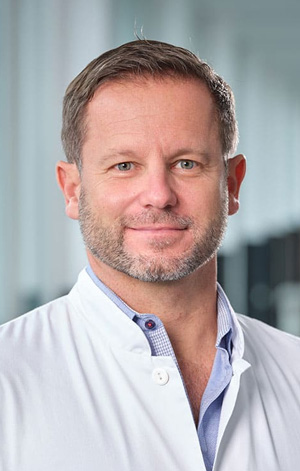Brain cysts
Arachnoid cysts
Arachnoid cysts are caused by a congenital duplication of the meninges. These benign cavities are filled with cerebrospinal fluid (CSF). They can occur anywhere in the cranial space. They are most often located between the frontal and temporal lobes in the Sylvian fissure.
Special techniques implemented at our centre
In our practice, arachnoid cysts are treated using endoscopic techniques. Advantage of this method is that the surgeon can open the cyst “under water”. If a cyst is operated on using a classic microsurgical technique, there is a risk that the cyst will collapse together with the adjacent cortex after the contents have been removed. The avulsion of superficial veins can lead to severe complications. A shunt of the cyst fluid into the abdominal cavity is now only performed in exceptional cases.
Colloid cysts
Colloid cysts typically occur in the front upper region of the third cerebrospinal fluid chamber (ventricle). These are benign cystic structures. However, they can lead to occlusive hydrocephalus resulting from blockage of the connection between the lateral ventricles and the third ventricle (foramen of Monro). This is life threatening.
Special techniques implemented at our centre
In principle, two surgical methods are available. Colloid cysts can be surgically removed via craniotomy. Although this has long been a standard method, it causes considerable surgery-related stress. In our clinic, we therefore prefer to implement the minimally-invasive endoscopic procedures.
This involves inserting a special endoscope into the anterior portion of the lateral cerebral fluid chamber. The optimal incision is planned with the help of neuronavigation. The colloid cyst can thus be removed exclusively using an endoscope with instruments millimetres in size (endoscopic scissors, forceps, coagulation electrodes, suction catheter).
The advantage of the endoscopic method is that less brain tissue is damaged by the endoscopic incision than in open surgery. The cranial incision is also much smaller (borehole instead of craniotomy). For a symptomatic colloid cyst, a bilateral shunt used to be inserted to relieve the damming.
This technique is obsolete because the cause can now be treated using minimally-invasive techniques.
Ventricular cysts
Cysts in cerebrospinal fluid chambers
Cysts in the cerebrospinal fluid chambers (ventricles) usually arise from membranes of the pia mater or cells of the ventricular wall. The cysts are never malignant. However, they often impair cerebrospinal fluid circulation, which can have serious consequences.
Special techniques implemented at our centre
For a symptomatic cerebral cyst, a shunt used to be inserted to divert the excess cystic fluid into the abdominal cavity. This technique is now outdated. In our practice, we treat ventricular cysts exclusively with endoscopic techniques. The aim of the operation is a fenestration of the cyst and restoration of cerebrospinal fluid circulation. With the help of navigation, the endoscope is inserted into the cerebrospinal fluid space and the cyst wall is dilated – the use of a shunt is no longer necessary.
Pineal cysts
Pineal cysts are benign cystic structures arising from the pineal gland. Beyond a certain size, it leads to the narrowing of the adjacent aqueduct (connection between the third and fourth cerebrospinal fluid chamber) with a disruption of cerebrospinal fluid circulation and the emergence of occlusive hydrocephalus. Using images alone, pineal cysts can be difficult to distinguish from tumours of the pineal gland.
Special techniques implemented at our centre
In principle, two surgical methods are available. For an extended ventricular system, we prefer a purely endoscopic technique. However, for narrow ventricles, we prefer an endoscopically-assisted microsurgical technique. In the purely endoscopic technique, the operation is performed via a borehole at the hairline from the onset. After the endoscope is inserted into the third cerebral ventricle, the pineal cyst is opened with special instruments and fenestrated; the tumour is either biopsied or removed. In narrow ventricles, the cyst is surgically opened and removed via an incision between the cerebellum and cerebellar tentorium. Here, a keyhole incision is made at the back of the head. The cyst is then reached using an endoscopically-assisted technique. Both methods have their place. The decision on which to use must be made on an individual basis according to the anatomical conditions.
